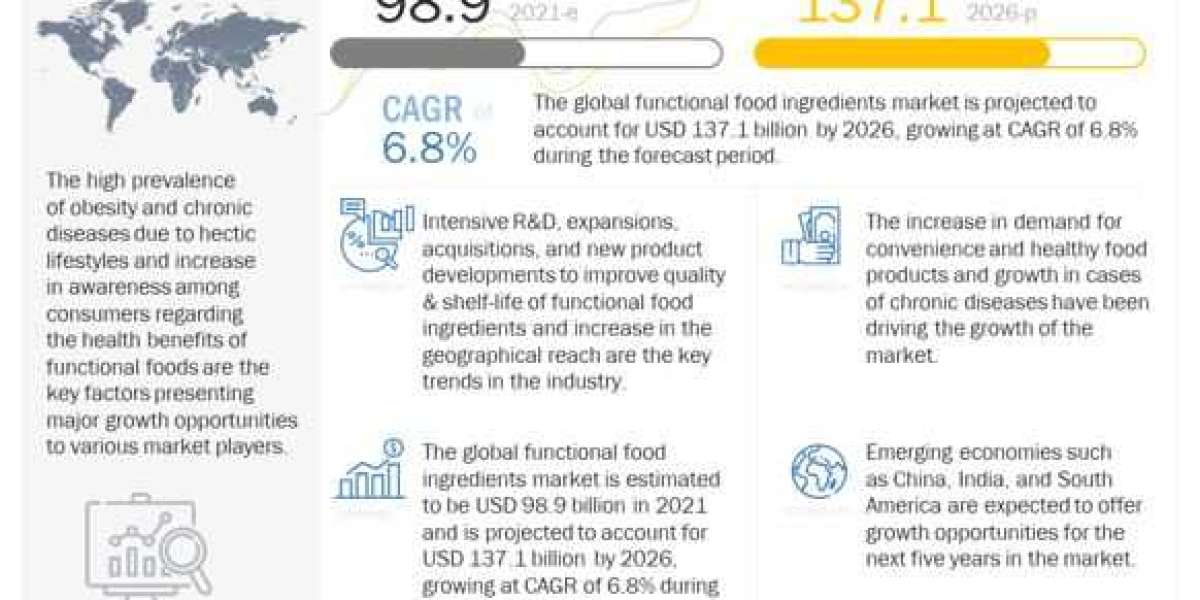The global functional food ingredients market size is estimated to be valued at USD 98.9 billion in 2021. It is projected to reach USD 137.1 billion by 2026, recording a CAGR of 6.8% during the forecast period. The inclination toward nutritional and convenience food and the rise in demand for fortified food beverage products are expected to drive the growth of the functional food ingredients market during the forecast period. However, factors such as adherence to the international quality standards regulations and lack of awareness about functional ingredients such as prebiotics and probiotics in developing countries act as restraints to the growth of the market.
Download PDF Brochure: https://www.marketsandmarkets.com/pdfdownloadNew.asp?id=9242020
Market Dynamics:
Drivers: Increase in consumption of nutritive convenience and fortified food
The global demand for fortified food is expanding at a robust pace. Functional food ingredients such as vitamins, minerals, antioxidants, hydrocolloids, prebiotics, amino acids, plant extracts, and carotenoids are the key ingredients of fortified food. The health-conscious population is rapidly expanding in emerging markets, which will drive the demand for the fortification of food. The nutritional consumption differences across regions contribute greatly to the apparent differences in the health of populations across the countries. Various factors such as increasing instances of chronic diseases and micronutrient deficiencies, growth of the middle class in emerging economies, new government fortification programs, growth of the world’s older population in regions such as Europe, and growing interest in health and wellness, owing to COVID-19, is expected to drive the sales of fortified foods, further driving the demand for functional food ingredients.
Restraints: Higher cost for functional food products due to the inclusion of healthier or naturally sourced ingredients
The development and commerce aspects of functional food ingredients are complex, expensive, and uncertain. Factors behind the success of product development are technological conditions, consumer demand, and legislative, regulatory background. Substantial investment is required for the RD of a strain to be used for the production of new functional ingredients such as probiotics. Probiotic strains and products are developed and produced in accordance with international food regulations. Also, highly sterilized and technical equipment and processes are required for the manufacturing and extraction of various other functional ingredients. As a result of the high cost of production, the price of the final product is also high. Marketing and distribution further add to the product price. Although consumers are aware of the health benefits derived from these expensive functional food ingredients, their high prices restrict consumers from buying the product
Opportunities: Adoption of new technologies in the functional food industry
The introduction of new technologies such as encapsulation, nanoencapsulation, and bio-encapsulation drives technological innovations in the functional food ingredients industry. Encapsulation technology helps in enhancing the taste of many food products. For instance, omega-3 fatty acids are associated with bad odor. The taste and fragrance of these ingredients are enhanced with the use of encapsulation technology. The recent advancements in liposome technology are being used in the manufacturing of several ingredients such as probiotics and other functional food ingredients, offering numerous health benefits. Thus, this has increased technological innovations for niche applications such as gourmet food and infant.
Challenges: Complexities related to the integration and adulteration of functional food products
Consumers’ knowledge of the health effects of specific ingredients can affect the acceptance of specific functional food. The common functional ingredients such as minerals, fiber, and vitamins are preferred over new and improved products such as foods enriched with probiotics, prebiotics, flavonoids, carotenoids, and conjugated linolenic acid.
The researcher has to work in-depth to overcome all the challenges related to the selection and development of strain and related production processes. The basic requirement for probiotics is that products should contain sufficient numbers of microorganisms up to the expiry date. Thus, probiotics must contain specific strains and maintain certain numbers of live cells for them to produce health benefits in the host.
Make an Inquiry: https://www.marketsandmarkets.com/Enquiry_Before_BuyingNew.asp?id=9242020
Key players in this market include Cargill, Incorporated (US), BASF SE (Germany), Archer Daniels Midland Company (US), DuPont (US), Arla Foods (Denmark), Kerry Group (Ireland), Ajinomoto Co., Inc. (Japan), Koninklijke DSM N.V. (Netherlands), Ingredion Incorporated (US), and Tate Lyle PLC (UK). Some of the other players include Chr. Hansen Holding A/S (Denmark), Kemin Industries, Inc. (US), BENEO (Germany), Royal Cosun (Netherland), Roquette Frères (France), Soylent (US), AB Ingredients (US), Golden Grain Group Limited (China), Sugarlogix (US), and Stratum Nutrition (US).


